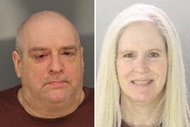Create a free profile to get unlimited access to exclusive videos, breaking news, sweepstakes, and more!
How Did A Model Employee Manage To Steal More Than $17 Million In Untraceable Cash?
Loomis Fargo employee David Ghantt and his partners nearly pulled off the perfect crime, but it would be their lavish spending, and an alleged murder plot, that would be their undoing.

David Ghantt had been a model employee for an armored car company before pulling off the second biggest cash heist in U.S. history, fleeing with more than $17 million in untraceable bills in 1997.
It was nearly the perfect crime, but while Ghantt fled to Mexico to lay low, his partners’ lavish spending—and their own alleged plans for murder—would ultimately be the group’s demise.
“Robbing the 7-Eleven and getting $40 bucks and a pack of Marlboros was not for me. I knew that if I did something like that, I would take a huge amount of money,” Ghantt said of the brash robbery on an upcoming episode of CNBC’s “Super Heists,” airing Monday at 10 p.m.
Ghantt, a U.S. Army veteran, was living a relatively “boring” life working as the vault superintendent at a Loomis Fargo armored car warehouse just outside Charlotte, North Carolina making a relatively meager paycheck, when he crossed paths with Kelly Campbell.
“In ’97 me and my wife were just barely scraping by,” Ghantt recalled in Monday’s episode. “We were two paychecks away from being homeless at any given time.”
Campbell—who was married herself—represented something new and exciting. Ghantt believed the new employee would “make a good replacement” for his wife, but the feelings were not necessarily reciprocated.
“I wasn’t attracted to him or anything, but he was a nice guy,” Campbell said.
Campbell left her job in the summer of 1997, but she would later use Ghantt’s feelings for her to her own advantage to get him to agree to carry out the multi-million-dollar heist.
The plan to rob Loomis Fargo was spawned by Campbell and her friend Steve Chambers, during a casual bonfire at Chambers’ home.
The pair began to daydream about whether they could really pull off the heist. Campbell knew they’d need the help of the warehouse’s vault supervisor, who just happened to have a crush on her, and she called Ghantt to ask for his help.
“He was like ‘OK, yeah, we can do that,’” she recalled. “It’s easy to get somebody to do something if you know that they are that infatuated with you.”
They got to work planning the straightforward heist that would rely on Ghantt’s existing access to the vault, fewer staff at the warehouse on the weekends, and the ability to use one of the company’s armored trucks to make the successful getaway.
Once Ghantt loaded the large haul from the vault—which could have been close to $20 million—into a truck, he planned to drive to a second location, then head straight to the airport and fly to Mexico. His partners, who planned to stay behind, agreed to send him his full cut of the money after the heat from investigators had died down.
“If I could get far enough away in a very short amount of time, my odds of getting away with it were pretty high,” Ghantt said.
Chambers also promised to join Ghantt in Mexico as soon as she could, but she admitted to “Super Heists” she never had any intention of actually making the trip.
Just days after agreeing to the plan, the group set a day to carry out the robbery. On Oct. 5, 1997, Ghantt carried out the heist during his regular shift after sending another employee home, stealing more than $17 million from the bank vault.
But there was just one thing the group hadn’t been counting on: the massive weight of that amount of cash. To make a successful getaway, Ghantt had to lift nearly 2,800 pounds of currency.
“I started just chucking it as fast as I could,” he said, adding the sweat was “pouring off of me.”
After loading the massive cache of loot into the armored truck, Ghantt set the time lock on the vault, which locked the door for days unless the employees drilled through the lock. The move bought him a little extra time to make his escape.
The plan went off with few problems, but after Ghantt was safely in Mexico, his partners were left storing large amounts of cash.
“I knew that if we could stay off the radar for about a year, we could basically live a vacation life,” Ghantt said.
But his partners soon began to get greedy and were spending large amounts—with Chambers and his wife, Michelle, even buying an exclusive mansion in cash.
“Of course, I went on a spending spree. (I) bought jewelry, bought a van,” Campbell recalled of her own spending.
Former Cramerton Police Chief David Young soon got wind of the Chambers’ excessive spending spree and reached out to the FBI.
Authorities began to hone in on the group and put a wire tap on Campbell's phones. While listening in, they uncovered another more sinister alleged plan to kill Ghantt.
“David Ghantt was a nuisance to Steve Chambers and Kelly Campbell,” John Wydra, a retired FBI agent who handled the case, told “Super Heists.”
As Campbell would later explain, “If David got killed, there couldn’t be any finger pointing. It’s kind of out of sight, out of mind,” she said of the reasoning.
Authorities said they hired a man named Michael McKinney to meet up with Ghantt and kill him, under the guise that he was planning to give Ghantt more of the money he was owed.
But before the hit could be carried out, the FBI swooped in and arrested Ghantt and the others.
“It was over. I knew it was over then,” Ghantt said.
To find out more about how the thieves got caught and how long they landed behind bars, tune in the “Super Heists” on CNBC on Monday at 10 p.m. ET/PT.

























